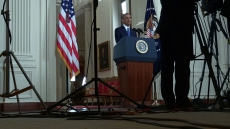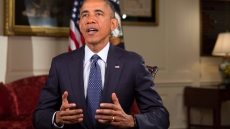Immigration and the Economy
“We are a nation of immigrants, and that means that we’re constantly being replenished with strivers who believe in the American Dream. And it gives us a tremendous advantage over other nations. It makes us entrepreneurial. It continues the promise that here in America, you can make it if you try, regardless of where you come from, regardless of the circumstances of your birth.”
— President Obama, November 21, 2014
It’s clear that fixing our broken immigration system would boost our economy and help all workers by increasing the worker productivity, creating more jobs, improving wages of all workers, and reducing the deficit. After waiting over 500 days for the House to take action on legislative solutions to fix our broken system, the President took the executive actions that help boost our economy.
According to analysis by the President’s Council of Economic Advisers (CEA), the President’s executive actions on immigration would boost economic output by an estimated 0.4 to 0.9 percent over ten years, corresponding to increases in GDP of $90 billion to $210 billion in 2024.
- The President’s actions will grow the economy by increasing the productivity of all American workers. These actions will increase the productivity of American workers, in part by allowing undocumented workers to come out of the shadows and find jobs that better match their skills and potential. This shift of workers across occupations will also allow more native workers to specialize in the tasks best suited to their abilities. These effects are likely to lead to wage increases for all workers — immigrants and natives alike. In addition, by encouraging high-skilled immigration, these actions will boost the rate of innovation and patenting in the American economy, further increasing the productivity of the American workforce.
- The President’s actions will increase the size of the American workforce. CEA estimates that the economy will also grow thanks to an expansion of the American labor force by nearly 150,000 people over 10 years as a result of the President’s executive actions.
- Average wages for all workers, both U.S.-born and immigrant, will increase. Increases in productivity and innovation caused by the President’s actions will translate into higher wages for all types of workers. CEA estimates that by 2024 annual wages for native workers will rise 0.3 percent, or approximately $170 in today’s dollars. CEA also estimates that the President’s actions would neither increase nor decrease the likelihood of employment for native workers.
- A bigger economy will reduce the deficit. As the economy grows so do tax revenues, requiring the government to borrow less to finance government operations. This reduced borrowing translates into reduced spending on interest payments by the government, thus reducing overall government spending — and shrinking the deficit. CEA’s estimate of the higher economic growth associated with executive action on immigration would translate into reductions in the Federal deficit by $25 billion in 2024.
At the same time, the President’s executive actions will expand the country’s tax base by millions of people and billions of dollars. Individuals potentially eligible for deferred action under the President’s executive actions are in the country today — and have been for many years. They provide for their families, just like all American citizens. Many are already in the workforce and contributing federal, state, and local taxes. But roughly two-thirds of them don’t pay taxes today. The President is changing that, ensuring that these individuals have the opportunity to apply for a work authorization and pay taxes. By allowing those eligible for deferred action to work in this country, both workers and employers will be able to come out from the shadows and contribute payroll taxes, just like all American citizens.
But these actions are just temporary improvements to our immigration system. Only Congress can make legislative changes that can fix our broken immigration system and boost our economy in a more substantial way. Study after study has shown that common-sense immigration reform will strengthen the economy, spur innovation and increase U.S. trade and exports.
Fixing our broken immigration system would increase America’s GDP.
![]()
A stronger GDP means a better standard of living for Americans.
The nonpartisan Congressional Budget Office (CBO) estimated that immigration reform would increase real Gross Domestic Product relative to current law projections by 3.3 percent in 2023 and 5.4 percent in 2033 – an increase of roughly $700 billion in 2023 and $1.4 trillion in 2033 in today’s dollars.
Immigrant-owned small businesses mean more jobs and a boost in demand for local goods.
![]()
Immigrants start small businesses.
According to the Partnership for a New American Economy, immigrants started 28 percent of all new business in 2011.
Immigrant-owned businesses create jobs for American workers.
According to the Fiscal Policy Institute, small businesses owned by immigrants employed an estimated 4.7 million people in 2007, and these small businesses generated more than $776 billion in revenue annually.
Immigrants boost demand for local consumer goods.
According to the 2010 American Community Survey, immigrants earned a total of $1.1 trillion, and the Immigration Policy Center estimates that the purchasing power of Latinos and Asians, many of whom are immigrants, alone will reach $1.5 trillion and $775 billion, respectively, by 2015.
More than 40 percent of Fortune 500 companies were founded by immigrants or a child of immigrants. According to the Partnership for a New American Economy these companies employ more than 10 million people worldwide and generate annual revenue of $4.2 trillion.
Ensure the next great breakthroughs in technology and medicine are developed in the United States by attracting and retaining the best and brightest students.
![]()
Immigrants innovate as scientists and engineers.
According to the National Survey of College Graduates, immigrants represent 29 percent of scientists. They also represent 50 percent of PhDs working in math and computer science occupations and 57 percent of PhDs working in engineering occupations.
Immigrants develop cutting-edge technologies and companies.
According to a paper from the National Bureau of Economic Research, immigration was responsible for one third of the explosive growth in patenting per capita in the 1990s, and these innovations contributed to increasing U.S GDP by 2.4 percent. According to the National Venture Capital Association, immigrants have started 25 percent of public U.S. companies that were backed by venture capital investors. This list includes Google, eBay, Yahoo!, Sun Microsystems, and Intel.
Immigrant scientist and engineers positively impact wages.
According to a study at the University of California – Davis, a 1 percent increase in the share of foreign scientist and engineers in the U.S. workforce would increase the wages of native college-educated workers by 4 to 6 percent, and have no significant effect on the wages and employment of native non-college-educated workers.
Fixing our broken immigration system is critical to bilateral trade and U.S. exports.
Investments to strengthen the border and facilitate more efficient trade with both Mexico and Canada will strengthen the U.S. economy. Canada and Mexico are our first and third trading partners in the world, respectively, together accounting for nearly one-third of U.S. exports in 2012 and more than $3.1 billion two-way trade per day in 2013. An increase in exports means more jobs right here in the U.S.
Fixing our broken immigration system will help increase international travel and
tourism to America.
Travel and tourism represent the largest service-export industry in the U.S., setting a record $180.7 billion in exports and supporting 8 million jobs in 2013. The economic impact and importance of travel and tourism will continue to grow in the coming years as emerging economies around the world experience an increase in their vacationing middle classes. China, Brazil, and India alone represent approximately 40 percent of the world’s population and by 2017 the number of travelers from those countries is expected to increase by 259 percent, 83 percent, and 47 percent respectively.
Download Economics of Commonsense Immigration Reform Fact Sheet (PDF)
View the Report: The Economic Benefits of Fixing Our Broken Immigration System
 Our journey is not complete until we find a better way to welcome the striving, hopeful immigrants who still see America as a land of opportunity; until bright young students and engineers are enlisted in our workforce rather than expelled from our country.
Our journey is not complete until we find a better way to welcome the striving, hopeful immigrants who still see America as a land of opportunity; until bright young students and engineers are enlisted in our workforce rather than expelled from our country.

President Barack Obama
January 21, 2013

